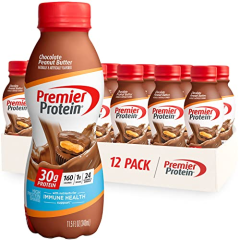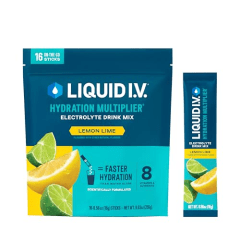You’ve definitely heard of Amazon Prime Day even if you’ve never bought something during the event. It’s nearly impossible to avoid: leading up to the Prime member-exclusive sale, there’s commercials about it on YouTube, influencers posting about it on social media, flashy billboards advertising it in Times Square and media outlets (like NBC Select) telling you everything you need to know about it. At this point, Prime Day is fully embedded in consumer culture — that’s especially impressive considering it’s only been around for about a decade, and it’s not tied to the holiday shopping season like Black Friday and Cyber Monday are.
Ever since its inception, Amazon has scaled Prime Day to record-breaking heights. The event brings in billions of dollars in global sales and drives up e-commerce activity across retailers. This year, Prime Day is making history yet again — it’s four days long (Jul. 8 to 11) rather than the typical two, doubling the amount of time shoppers have to take advantage of deals.
To contextualize Prime Day and its impact on e-commerce, I charted the event’s history from the first year it began to now. I also consulted experts about its growth, the challenges it’s currently facing and what to expect during Prime Day 2025.
Want more from NBC Select? Sign up for our newsletter, The Selection, and shop smarter.
How did Prime Day start?
The first-ever Prime Day took place on July 15, 2015 to celebrate the company’s 20th anniversary, according to Amazon. It lasted 24 hours and was available to members in nine countries: the United States, United Kingdom, Spain, Japan, Italy, Germany, France, Canada and Austria. Since 2015, Prime Day has expanded its reach — Amazon now hosts the sale for four days in over 20 countries, and runs a second version of Prime Day, Prime Big Deal Days, in October to kick off the holiday shopping season.
One of the factors that makes Prime Day so unique is that it’s an event Amazon manufactured, unlike Black Friday and Cyber Monday, both of which are tied to the holiday shopping season. Prime Day (the first one, anyway) is traditionally held in mid-July, which is a strategic decision on the company’s part: The summer is a slower period for retailers, and Prime Day is an attempt to remedy that. “Prime Day provides Amazon with a jolt during an otherwise dormant shopping season,” says Dr. Ross Steinman, a professor of consumer psychology at Widener University. Hosting Prime Day during the week is a strategic decision, too. Summer weekends are reserved for relaxing, sleeping in, leisure activities and traveling, but Amazon knows it can capture shoppers’ attention during the week.
Why does Amazon host Prime Day?
There’s three big reasons why Amazon hosts Prime Day: to attract new Prime members, retain the members it already has and drive sales to its marketplace.
Amazon’s goal is to accrue an army of repeat shoppers who take advantage of everything a Prime membership offers them year-round, not just during one big sale. However, Prime Day is an entry point to a Prime membership. The sale puts its benefits on full display and exposes shoppers to the retailer’s “ecosystem of consumption,” meaning its network of platforms like Prime Music, Whole Foods grocery delivery, Prime Video, Audible and Kindle Unlimited. And once you’re in Amazon’s ecosystem, it’s hard to leave, says Steinman.
“Amazon’s goal is to be sticky,” he says. “Once a consumer is in the Amazon ecosystem, they’re going to spend largely double what a non-Prime member will.”
The retailer also wants to impress the Prime members it already has, reminding them why the loyalty program is worth paying $139 for a year. “Prime is one of the biggest money makers on the retail side of Amazon, so it needs to justify the cost of the subscription fee and provide more value, especially as the cost goes up,” says Jeffrey Galak, an associate professor of marketing at Carnegie Mellon University’s Tepper School of Business. “Prime Day is a perfect example of that, as is hosting a second Prime-level event in October.”
As for driving sales to Amazon’s marketplace, hundreds of brands offer deals during Prime Day, but those the retailer owns, like Fire, Kindle and Ring, tend to drop prices the most. Discounting Amazon-owned devices is particularly lucrative for the retailer because they’re designed to increase your purchases on Amazon, says Steinman. The majority of this tech is equipped with Amazon Alexa, a virtual assistant who can notify you about deals and even make purchases if you give her permission. Deeply discounting its products is also an effective way for Amazon to offload old merchandise, especially if it plans to release a new model later in the year, says Galak.
There’s one more reason Prime Day is such an important event for the company: “It’s a stress test for the holidays,” says Steinman. “Prime Day creates an artificial surge in orders, similar to what the retailer experiences between November and December, so it provides Amazon with an opportunity to do a test run. They can see if they need to work out any kinks as they get closer to the formal holiday shopping season.”
What challenges is Prime Day currently facing?
As far as Prime Day is concerned, one of Amazon’s biggest challenges right now is attracting new subscribers. All the experts I talked to say Prime members are at a saturation point, at least in the United States — in 2024, for example, 86% of Prime Day shoppers were members for more than a year, according to a survey by Numerator. Since the sale is partly about encouraging new member sign ups, the retailer is officially at a crossroads, says Steinman.
“In order for Prime to continue growing and making money, Amazon either has to find a new audience or increase the fee,” says Galak. Finding a new audience is much harder to do, but the retailer is trying. It recently relaunched its Prime for Young Adults membership (formerly Prime Student), an attempt at appealing to 18 to 24 year olds so they can become part of the loyalty program in college and transition to a standard membership later on, says Steinman. Amazon also plans to expand its same-day delivery program to rural areas and smaller towns across the country, giving those who live there a reason to sign up.
Prime Day results from July 2024
Amazon has not disclosed sales from Prime Day 2024, which marked the mega sale’s tenth anniversary. But Adobe Analytics estimates that sales hit $14.2 billion during the 48-hour event, and Amazon says it was the biggest Prime Day yet with more items sold than ever before. Bestselling items include the Amazon Fire TV Stick, Premier protein shakes, Liquid I.V. packets, Glad trash bags and Cosrx snail mucin serum, according to Numerator. Something these items have in common? They’re typically personal purchases, many of which you need to frequently restock, which means people are shopping for themselves during Prime Day. The event is in the middle of the summer, so members buy items they want and need, unlike Black Friday and Cyber Monday, which are when people start shopping for holiday gifts.
What to expect during Prime Day 2025
Shoppers know what to expect from Amazon’s mega sale at this point. “About a decade in, Prime Day is like a movie you’ve watched a million times,” says Steinman. “You know the arc, the plot and the ending, but you still sit down to watch it to the end. There are no surprises, which offers comfort for Prime subscribers.”
That said, there’s one big change this year: four days to shop the sale rather than two. Experts agree that doubling Prime Day’s timeline is a wise move on the retailer’s part, but there’s more to it than just assuming more time to shop equals more purchases — it’s also about optics. “When you expand into a four-day event, you’re really putting an anchor down and saying, ‘this is a Black Friday shopping type moment,’ signaling to consumers that’s what they should expect,” says Vivek Pandya, the manager of Adobe Digital Insights.
Extending Prime Day aligns with shoppers’ general awareness around the sale, too. “When you have a sale under a super tight time constraint, it builds hype, and that worked well for Amazon initially because it built a lot of buzz around Prime Day,” says Galak. “But that level of hype is no longer needed. Half of America is on Amazon Prime, so you don’t need to build that buzz as much. Instead, give people the opportunity to transact again and again.”
While more time to shop deals sounds great in theory, it presents Amazon with a new challenge: capturing shoppers’ attention for four days and keeping up momentum. This year, however, Pandya doesn’t expect that to be an issue. Consumers are currently very price sensitive due to concerns around tariffs, inflation and job security, which is exponentially increasing their appetite for sales. “When consumers have the opportunity to take advantage of deals, we’re seeing them really over-index their spending,” he says. “They understand that pricing dynamics are more favorable for them during one of these sales periods versus outside of them, so that’s why we’re expecting some really strong growth for this Prime event.”
Overall, Pandya expects Prime Day 2025 sales to significantly outperform an average online shopping day and shatter the retailers’ records. Deals will likely be on par with what they were last year — many shoppers were concerned that tariffs might force brands to offer weaker deals, but so far, they’re staying rather competitive, he says.
Additionally, Pandya is keeping an extra-close eye on how Amazon is engaging influencers to reach shoppers on social media, and promoting AI integrations like its Rufus shopping assistant. He believes both trends will contribute to increased mobile spending this year. “When you have consumers spending so much time on their smartphones, the question becomes how much impulse buying can happen when deals come through in an email or pop up on their social feeds,” says Pandya. “We usually see consumers take action relatively quickly.”
What are the best products to buy during Prime Day?
There’s an inaccurate stereotype about shoppers during huge sale events like Prime Day, says Steinman. “The perception is that somebody’s going to get swept up in excitement and engage in a number of impulse purchases,” he says. “But by and large, that’s not what happens on Prime Day.”
For the most part, Prime Day shoppers are savvy — they’re conscious about using the sale to their advantage and spending strategically, says Steinman. Many compare prices across retailers to determine whether a deal is worth taking advantage of, and save their bucket list-type purchases for Black Friday. That’s not to say shoppers ignore deals on luxury or “non-essential” items, however. There’s almost always an uptick in spending on cosmetics, apparel and tech during Prime Day, which is balanced with spending on household basics and pantry staples, says Pandya.
Shoppers don’t know exactly what Amazon is discounting on Prime Day until the sale starts, which is part of the event’s allure. Prime Day bestsellers vary from year to year and from country to country, which isn’t just the result of different buying habits — deals in one country aren’t always reflective of another. But factors like a discount being well-advertised or well-priced can contribute to a product becoming a bestseller, as can Amazon’s agenda of selling as many of its devices as possible. Brands also use Prime Day to slash prices on soon-to-be out-of-season or out-of-style merchandise.
Some of the best Prime Day discounts are Amazon’s Lightning Deals, flash sales that give shoppers a short window to purchase limited quantities of specific products. Lightning Deals put shoppers in a competitive mindset and add what Steinman calls a “gamification” aspect to the sale. Shoppers don’t have time to think about whether they need the item being sold as a Lightning Deal, so they impulsively buy it because they don’t want to miss out.
Prime Day’s impact on other retailers
By hosting Prime Day in July, Amazon permanently altered the retail calendar. It created the blueprint for a member-exclusive flagship summer sale, and proved that it’s powerful enough to create a halo effect on e-commerce by driving purchases to other sites as well as its own. That forced competitors like Walmart, Target, Macy’s and Best Buy to respond, says Galak.
Since the first Prime Day in 2015, many retailers have changed the timing of their biggest sales to align with the dates of Amazon’s, or created new ones, like the Walmart Deals event and Target Circle Week. Amazon’s competitors hope that shoppers will spill over onto their sites and make additional purchases, which happens often. In 2024, 35% of Prime members shopped Target Circle Week, 35% shopped the Walmart Deals event and 12% shopped Best Buy’s Black Friday in July, according to a survey by Numerator.
“Amazon is in the driver’s seat, but retailers acknowledge that this is a real opportunity for them to capitalize on, so they need to employ all forces to help enable spending,” says Pandya.
What is Prime Big Deal Days?
For the first time in 2022, Amazon hosted two Prime Day-level events in one year: Prime Day in July and the Prime Early Access Sale in October. Amazon has followed that schedule ever since but changed the name of the October event to Prime Big Deal Days.
Although hosting a second Prime Day-level event in October takes away some of the novelty July’s sale became known for, it’s Amazon’s attempt to kick off the holiday shopping season, experts told me. Many of the retailer’s competitors now start their early Black Friday promotions in October to give shoppers extra time to buy gifts, so Amazon responded with a sale of its own. Adding another mega sale to the calendar is also evidence that Amazon is trying to drive more membership sign ups, says Steinman. “It plays on shoppers’ fear of missing out on a great deal by creating the idea that member-exclusive events can take place at any point,” he says.
Amazon doesn’t disclose sales figures, so we don’t know exactly how Prime Big Deal Days compares to Prime Day from a revenue standpoint. However, discounts during the October event are typically lackluster compared to July, and people don’t feel the same level of pressure to shop, experts say. The summer isn’t filled with opportunities to take advantage of sales beyond Prime Day, which works in its favor. But shoppers know that Black Friday and Cyber Monday deals start as early as October across dozens of retailers, so they usually don’t approach Prime Big Deal Days with urgency.
Meet our experts
At NBC Select, we work with experts who have specialized knowledge and authority based on relevant training and/or experience. We also ensure that all expert advice and recommendations are made independently and with no undisclosed financial conflicts of interest.
- Dr. Ross Steinman is a professor of consumer psychology at Widener University.
- Jeffrey Galak is an associate professor of marketing at Carnegie Mellon University’s Tepper School of Business.
- Vivek Pandya is the manager of Adobe Digital Insights.
Why trust NBC Select?
I’m a reporter at NBC Select who’s covered sales and deals for five years, including topics like Amazon Prime Day, Black Friday and Cyber Monday. To write this article, I interviewed three experts about Amazon Prime Day and its impact on the retail industry.
Catch up on NBC Select’s in-depth coverage of tech and tools, wellness and more, and follow us on Facebook, Instagram, Twitter and TikTok to stay up to date.









